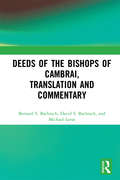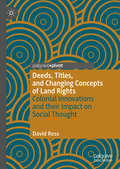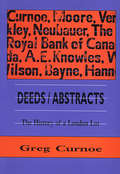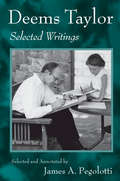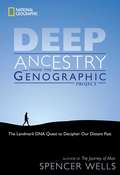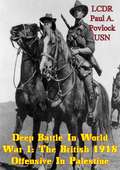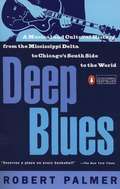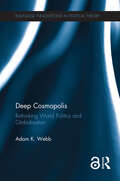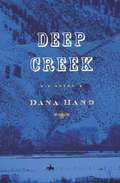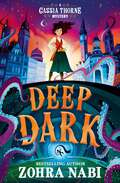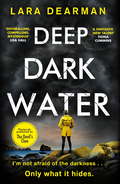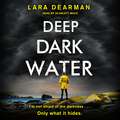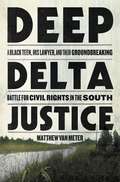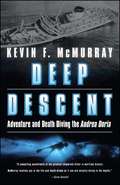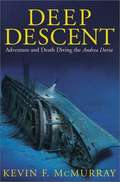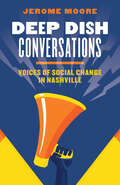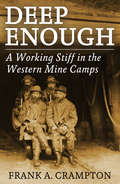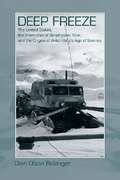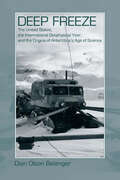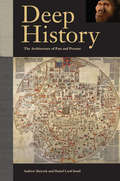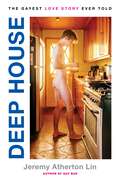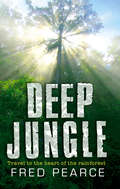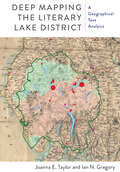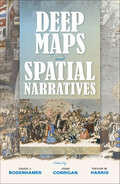- Table View
- List View
Deeds of the Bishops of Cambrai, Translation and Commentary: Translation And Commentary
by Bernard S. Bachrach David S. Bachrach Michael LeeseFirst commissioned by Bishop Gerard I of Cambrai (1012-1051) in 1023 or 1024, the Gesta episcoporum Cameracensium was the work of two authors, the second of whom completed the text shortly after the death of Bishop Gerard. The three books of the Gesta shed considerable light on the policies and actions of many of the key political and religious figures in an economically and intellectually vibrant region on the frontier between the German and French kingdoms. The Deeds of the Bishops of Cambrai, translated in this volume into English for the first time, provides unique insights into the relationship between the German king and the bishops within the context of the so-called imperial church system, the rise of both secular and ecclesiastical territorial lordships, the conduct of war, the cult of the saints, monastic reform, and evolving conceptions of the proper social order of society. Including extensive commentary, apparatus of explanatory notes, maps, genealogies, this text will be of considerable value both in undergraduate and graduate courses as well as to scholars.
Deeds, Titles, and Changing Concepts of Land Rights: Colonial Innovations and Their Impact on Social Thought
by David RessThis book explores the history of public land tenure records, which first began in colonial Massachusetts as English settlers and Native Americans tried to resolve differing ideas about rights to land in the seventeenth century. In South Australia, a similar method of state certification of land ownership arose in the nineteenth century, through Torrens system title registration – a process that would be widely adopted in British and American colonies as a particularly effective way of guaranteeing absolute ('fee simple') ownership over indigenous peoples’ land. This book explores the similarities between these two record systems, highlighting how similar settlement patterns and religious beliefs in both places focused attention on recording land tenure, and illustrating how these record systems encouraged new ways of thinking about rights to and on land.
Deeds/Abstracts: The History of a London Lot
by Greg CurnoeBefore his tragic death in 1992, Greg Curnoe had submitted to Brick Books a manuscript based on extraordinarily detailed research into the history of 38 Weston, his address in London, Ontario. The result is a journal/collage that traces the occupancy of that one small plot of land hundreds of years back into aboriginal times when land in this country was not plotted according to the laws of geometry. Deeds/Abstracts is an intensely concentrated and particular cross-section of Canadian history, layer upon layer upon layer. Brick Books is proud to offer this exemplary work-in-progress (a 500-year diary can never be complete) assembled by a much-loved and keenly-lamented Canadian artist of the first importance. Front and back covers are after paintings by Greg Curnoe. The text includes 12 colour plates of photographs and Curnoe paintings.
Deems Taylor: Selected Writings
by James PegolottiDeems Taylor (1885-1966) was a composer, music critic, author, commentator, translator, and artist. He was the first American composer commissioned to write an opera by New York’s Metropolitan Opera, and composed orchestral and solo works that remain part of the repertoire. He gained fame initially introducing the regular radio broadcasts of the New York Philharmonic in the mid-‘30s; his fame was so great, that animator Walt Disney invited him to be the on-screen host of Fantasia. Taylor wrote for many popular journals, including Vanity Fair and the New Yorker, as well as the daily press, and his work was collecting in many best-selling books. Taylor’s biographer, James Pegolotti, has made a fresh selection of the best of Taylor’s writings on music for this new volume. Divided into parts reflecting a chronological look at Taylor’s entire career, the work exposes the reader to Taylor’s wit and keen intellect. Pegolotti has written brief introductions for each section, placing Taylor’s work in the context of its time.Deems Taylor: Selected Writings brings into full view a forgotten important music reviewer and social commentator of the first half of the twentieth century.
Deep Ancestry: Inside the Genographic Project
by Spencer WellsLaunched in 2005, the Genographic Project is the largest genetic study of human migration ever mounted. In this accessible text, Project Director and National Geographic Explorer-in-Residence Spencer Wells provides an overview of what is understood so far and describes what scientists hope to learn as the project progresses. He uses the stories of five individual program participants as examples for explaining how historical details are gleaned from DNA and exploring the larger issues involved in the research. Annotation ©2007 Book News, Inc., Portland, OR (booknews.com)
Deep Battle In World War I: The British 1918 Offensive In Palestine
by LCDR Paul A. Povlock USNManeuver Warfare Theory achieved major acceptance during the 1980's, emphasizing the conduct of simultaneous offensive operations throughout the depth of the battlefield. With the victory of Coalition forces during Operation DESERT STORM, the "deep battle" theory gained instant credibility and the emphasis on "joint" operations reached a fever pitch. Yet, too often analysts have only used the war in Kuwait to prove or refute these operational concepts. All theories require more than one case study to validate or nullify their precepts. Other historical examples need to be examined using the model of maneuver warfare to give greater support for this theory.While the First World War is often characterized by the futile attrition of the Western Front in France, many exceptional operational offensives were also conducted. The British September 1918 offensive in Palestine is a superb example of the proper application of combat forces at the operational level. General Edmund Allenby's use of regular army units, armored cars, cavalry, airpower and irregulars led to a major victory that hastened the collapse of Turkey and the Central Powers. Long before mechanized forces and maneuver theory had been developed, British Imperial forces executed an operational design stressing many elements of deep battle theory.By examining the British offensive using the paradigm of maneuver warfare, additional evidence can be generated to add credence to the theory. The importance of the synergistic effect of combat arms when applied jointly is also shown. Maneuver theory must be better understood if this paradigm is used to create doctrine for the employment of the Armed Forces of the United States.
Deep Blues: A Musical and Cultural History of the Mississippi Delta
by Robert PalmerBlues is the cornerstone of American popular music, the bedrock of rock and roll. In this extraordinary musical and social history, Robert Palmer traces the odyssey of the blues from its rural beginnings, to the steamy bars of Chicago’s South Side, to international popularity, recognition, and imitation. Palmer tells the story of the blues through the lives of its greatest practitioners: Robert Johnson, who sang of being pursued by the hounds of hell; Muddy Waters, who electrified Delta blues and gave the music its rock beat; Robert Lockwood and Sonny Boy Williamson, who launched the King Biscuit Time radio show and brought blues to the airwaves; and John Lee Hooker, Ike Turner, B. B. King, and many others.
Deep Cosmopolis: Rethinking World Politics and Globalisation (Routledge Innovations in Political Theory)
by Adam K. WebbToo often, observers of globalization take for granted that the common ground across cultures is a thin layer of consumerism and perhaps human rights. If so, then anything deeper and more traditional would be placebound, and probably destined for the dustbin of history. But must this be so? Must we assume--as both liberals and traditionalists now tend to do--that one cannot be a cosmopolitan and take traditions seriously at the same time? This book offers a radically different argument about how traditions and global citizenship can meet, and suggests some important lessons for the contours of globalization in our own time. Adam K. Webb argues that if we look back before modernity, we find a very different line of thinking about what it means to take the whole world as one’s horizon. Digging into some fascinating currents of thought and practice in the ancient world, the Middle Ages, and the early modern period, across all major civilizations, Webb is able to reveal patterns of "deep cosmopolitanism", with its logic quite unlike that of liberal globalization today. In their more cosmopolitan moments, everyone from clerics to pilgrims to empire-builders was inclined to look for deep ethical parallels—points of contact—among civilizations and traditions. Once modernity swept aside the old civilizations, however, that promise was largely forgotten. We now have an impoverished view of what it means to embrace a tradition and even what kinds of conversations across traditions are possible. In part two, Webb draws out the lessons of deep cosmopolitanism for our own time. If revived, it has something to say about everything from the rise of new non-Western powers like China and India and what they offer the world, to religious tolerance, to global civil society, to cross-border migration. Deep Cosmopolis traces an alternative strand of cosmopolitan thinking that cuts across centuries and civilizations. It advances a new perspective on world history, and a distinctive vision of globalization for this century which has the real potential to resonate with us all.
Deep Cosmopolis: Rethinking World Politics and Globalisation (Routledge Innovations in Political Theory)
by Adam K. WebbToo often, observers of globalization take for granted that the common ground across cultures is a thin layer of consumerism and perhaps human rights. If so, then anything deeper and more traditional would be placebound, and probably destined for the dustbin of history. But must this be so? Must we assume--as both liberals and traditionalists now tend to do--that one cannot be a cosmopolitan and take traditions seriously at the same time? This book offers a radically different argument about how traditions and global citizenship can meet, and suggests some important lessons for the contours of globalization in our own time.Adam K. Webb argues that if we look back before modernity, we find a very different line of thinking about what it means to take the whole world as one’s horizon. Digging into some fascinating currents of thought and practice in the ancient world, the Middle Ages, and the early modern period, across all major civilizations, Webb is able to reveal patterns of "deep cosmopolitanism", with its logic quite unlike that of liberal globalization today. In their more cosmopolitan moments, everyone from clerics to pilgrims to empire-builders was inclined to look for deep ethical parallels—points of contact—among civilizations and traditions. Once modernity swept aside the old civilizations, however, that promise was largely forgotten. We now have an impoverished view of what it means to embrace a tradition and even what kinds of conversations across traditions are possible. In part two, Webb draws out the lessons of deep cosmopolitanism for our own time. If revived, it has something to say about everything from the rise of new non-Western powers like China and India and what they offer the world, to religious tolerance, to global civil society, to cross-border migration.Deep Cosmopolis traces an alternative strand of cosmopolitan thinking that cuts across centuries and civilizations. It advances a new perspective on world history, and a distinctive vision of globalization for this century which has the real potential to resonate with us all.
Deep Creek: A Novel
by Dana HandOne of the Washington Post&’s Best Novels of the Year: A &“fascinating&” tale of murder in 1880s Idaho, based on real historical events (The Daily Beast). Idaho Territory, June 1887. A small-town judge takes his young daughter fishing, and she catches a man. Another body surfaces, then another. The final toll: over thirty Chinese gold miners brutally murdered. Their San Francisco employer hires Idaho lawman Joe Vincent to solve the case. Soon he journeys up the wild Snake River with Lee Loi, an ambitious young company investigator, and Grace Sundown, a métis mountain guide with too many secrets. As they track the killers across the Pacific Northwest, through haunted canyons and city streets, each must put aside lies and old grievances to survive a quest that will change them forever. Deep Creek is a historical thriller inspired by actual events and people: the 1887 massacre of Chinese miners in remote and beautiful Hells Canyon, the brave judge who went after their slayers, and the sham race-murder trial that followed. In this enhanced ebook edition, Deep Creek teams history with invention, setting authentic photographs and maps alongside the authors&’ brilliant fiction to illuminate this long-forgotten American tragedy, in a tale of courage and redemption, loss and love. The Washington Post has named Deep Creek a Best Novel of 2010, and The Daily Beast/Newsweek ranked it among the dozen best Western novels since 1960.
Deep Dark (A Cassia Thorne Mystery #1)
by Zohra Nabi'This book is stunning – Zohra Nabi writes like a dream and has achieved the impossible by conjuring up a living, breathing Victorian London right before my eyes. I felt like I was right there with Cassia while reading it, magic sparkling around us.' – Natasha Hastings, author of The Miraculous SweetmakersThe dark was deep; it opened like a cavernous mouth and swallowed the boy whole. Cassia Thorne leads a double life. By day, she sells ballads at Bartholomew Fair. By night she spends her evenings locked up in Fleet Prison. Cassia has plans of escaping both of these lives. But this year there are rumours of children being snatched off of the streets of London and no one willing to help. So Cassia decides to take matters into her own hands; with the help of a young pickpocket, Teo and her friend Felix, Cassia starts to investigate the disappearances. She soon discovers a sinister conspiracy at the heart of the city - mysterious men in blue coats and whispers of a beast that lives in the deep dark tunnels below the city. Can Cassia get to the bottom of the mystery and rescue the missing children before it's too late? Join Cassia and her friends on a spine-tingling supernatural adventure through the streets of London!A breathtaking new direction from a rising star and the author of The Kingdom Over the Sea, a Waterstone's Children's Book of month. Praise for Deep Dark: &‘A spine-tingling, Dickensian adventure.&’ – The Bookseller &‘An atmospheric adventure with a wonderfully engaging heroine – this richly evocative story will sweep you away to the streets of 19th century London.&’ – Katherine Woodfine, author of The Clockwork Sparrow &‘An extraordinarily thrilling, fantastical adventure through London with a monstrous twist! Deep Dark is a rallying cry for justice.&’ – Lizzie Huxley-Jones, author of Vivi Conway and the Sword of Legend &‘An eerie and intricate tale that holds you fast and drags you beneath the surface of Victorian London . . . unputdownable.&’ – Sarah Underwood, author of Lies We Sing to the Sea
Deep Dark Water: A tense crime thriller to keep you up all night (Jennifer Dorey)
by Lara DearmanAn atmospheric new crime series set in the Channel Islands, for readers of Ann Cleeves, Peter May and LJ Ross, introducing investigative journalist Jennifer Dorey. Jennifer Dorey thinks she is safe. Following a traumatic incident in London, Jennifer has returned to her childhood home in Guernsey, taking a job as a reporter at the local newspaper. After the discovery of a drowned woman on a beach, she uncovers a pattern of similar deaths that have taken place over the past fifty years. Together with DCI Michael Gilbert, an officer on the verge of retirement, they follow a dark trail of island myths and folklore to 'Fritz', the illegitimate son of a Nazi soldier. His work, painstakingly executed, has so far gone undetected. But with his identity about to be uncovered, the killer now has Jennifer in his sights.And home is the last place she should be.DEEP DARK WATER introduces readers to returning characters journalist Jennifer Dorey and DCI Michael Gilbert. Previously published as The Devil's Claw*************************What readers are saying about Lara Dearman's Channel Island mysteries:'I've never been to Guernsey but this book has made me add it to my bucket list!' 'Reminds me of the excellent "Bergerac" detective series.''I can't wait for the next Jennifer Dorey instalment''Guernsey makes a wonderful setting for the book''Found it very gripping and could not put it down.'
Deep Dark Water: A tense crime thriller to keep you up all night (Jennifer Dorey)
by Lara DearmanThis title was previously published in 2017 with the original title, 'The Devil's Claw''With a unique protagonist, and a brilliant setting, Lara Dearman creates more tension than a suspension bridge as you hold your breath through the book.' Helen Fields, author of Perfect SilenceAn atmospheric new crime series set in the Channel Islands, for readers of Ann Cleeves, Peter May and Elly Griffiths. Jennifer Dorey thinks she is safe. Following a traumatic incident in London, Jennifer has returned to her childhood home in Guernsey, taking a job as a reporter at the local newspaper. After the discovery of a drowned woman on a beach, she uncovers a pattern of similar deaths that have taken place over the past fifty years. Together with DCI Michael Gilbert, an officer on the verge of retirement, they follow a dark trail of island myths and folklore to 'Fritz', the illegitimate son of a Nazi soldier. His work, painstakingly executed, has so far gone undetected. But with his identity about to be uncovered, the killer now has Jennifer in his sights.And home is the last place she should be.DEEP DARK WATER introduces readers to returning characters journalist Jennifer Dorey and DCI Michael Gilbert. *************************'A dark, thrilling murder mystery in a richly-realised setting--the best debut I've read this year' Mason Cross, author of Don't Look for Me'Highly competent . . . and appealingly heartfelt' Kirkus Reviews'Atmospheric and tense. Superb!' Isabel Ashdown, author of Little Sister'A powerful debut. with smooth prose and engaging characters, Dearman draws her readers into a tangle web of secrets' Karen Dionne, author of The Marsh King's DaughterWhat readers have said about Deep Dark Water:'Atmospheric and superbly written' Amazon'A real page turner, keeping you guessing until the end' Amazon'Superb new series with great characters and amazing scenery. Loved it!' Amazon'A deadly mystery, with its roots in the historical past. I am so hooked!' Goodreads'This is a hugely assured and absorbing debut novel' Goodreads
Deep Delta Justice: A Black Teen, His Lawyer, and Their Groundbreaking Battle for Civil Rights in the South
by Matthew Van MeterThe "arresting, astonishing history" of one lawyer and his defendant who together achieved a "civil rights milestone" (Justin Driver). In 1966 in a small town in Louisiana, a 19-year-old black man named Gary Duncan pulled his car off the road to stop a fight. Duncan was arrested a few minutes later for the crime of putting his hand on the arm of a white child. Rather than accepting his fate, Duncan found Richard Sobol, a brilliant, 29-year-old lawyer from New York who was the only white attorney at "the most radical law firm" in New Orleans. Against them stood one of the most powerful white supremacists in the South, a man called simply "The Judge." In this powerful work of character-driven history, journalist Matthew Van Meter vividly brings alive how a seemingly minor incident brought massive, systemic change to the criminal justice system. Using first-person interviews, in-depth research and a deep knowledge of the law, Van Meter shows how Gary Duncan's insistence on seeking justice empowered generations of defendants-disproportionately poor and black-to demand fair trials. Duncan v. Louisiana changed American law, but first it changed the lives of those who litigated it.
Deep Descent: Adventure and Death Diving the Andrea Doria
by Kevin F. McMurrayAn in-depth look at the danger of diving the Andrea Doria, the "Everest" of deep-sea diving, by an award-winning journalist and photographer.On a foggy July evening in 1956, the Italian cruise liner Andrea Doria, bound for New York, was struck broadside by another vessel. In eleven hours, she would sink nearly 250 feet to the murky Atlantic Ocean floor. Thanks to a daring rescue operation, only fifty-one of more than 1,700 people died in the tragedy. But the Andrea Doria is still taking lives. Considered the Mount Everest of diving, the Andrea Doria is the ultimate deepwater wreck challenge. Over the years, a small but fanatical group of extreme scuba divers have investigated the Andrea Doria, pushing themselves to the very limits of human endurance to explore her—and not all have returned. Diver Kevin McMurray takes you inside this elite club with a hard, honest look at those who go deeper, farther, and closer to the edge than others would ever dream. Deep Descent is the riveting true story of the human spirit overcoming human frailty and of fearsome, mortal risks traded for a hard-core adrenaline rush. Chronicling these adventures in his page-turning narrative and in dozens of dramatic photos, McMurray draws us deeper into the cold heart of the unforgiving sea, giving us a powerful vision of a place to which few will ever have the skills—or the courage—to go.
Deep Descent: Adventure and Death Diving the Andrea Doria
by Kevin McmurrayOn a foggy July evening in 1956, the Italian cruise liner Andrea Doria, bound for New York, was struck broadside by another vessel. In eleven hours, she would sink nearly 250 feet to the murky Atlantic Ocean floor. Thanks to a daring rescue operation, only 51 of more than 1,700 people died in the tragedy. But the Andrea Doria is still taking lives. Considered the Mt. Everest of diving, the Andrea Doria is the ultimate deepwater wreck challenge. Over the years, a small but fanatical group of extreme scuba divers have investigated the Andrea Doria, pushing themselves to the very limits of human endurance to explore her -- and not all have returned. Diver Kevin McMurray takes you inside this elite club with a hard, honest look at those who go deeper, farther, and closer to the edge than others would ever dream. Deep Descent is the riveting true story of the human spirit overcoming human frailty and of fearsome, mortal risks traded for a hard-core adrenaline rush. Chronicling these adventures in his page-turning narrative and in dozens of dramatic photos, McMurray draws us deeper into the cold heart of the unforgiving sea, giving us a powerful vision of a place to which few will ever have the skills -- or the courage -- to go.
Deep Dish Conversations: Voices of Social Change in Nashville
by Jerome MooreWhat does it mean to be a Nashvillian? A Black Nashvillian? A white Nashvillian? What does it mean to be an organizer, an ally, an elected official, an agent for change? Deep Dish Conversations began as a running online interview series in which host Jerome Moore sits down over pizza with Nashville leaders and community members to talk about the past, present, and future of the city and what it means to live here. The result is honest conversation about racism, housing, policing, poverty, and more in a safe, brave, person-to-person environment that allows for disagreement. This book is a curated collection of the most striking interviews from the first few seasons of the series, with a foreword by Dr. Sekou Franklin, an introduction by Moore, and contextual introductions to each interviewee. Figures like Judge Sheila Calloway, comedian Josh Black, anti-racism speaker Tim Wise, organizer Jorge Salles Diaz, and many more explore their wide-ranging perspectives on social change in a city in the midst of massive demographic and ideological shifts. For anyone in any twenty-first-century city, Deep Dish Conversations offers a lot to think about—and a lot of ways to think about it.
Deep Enough: A Working Stiff in the Western Mine Camps
by Frank A. CramptonDeep Enough, first published in 1956, is the adventure-filled autobiography of Frank Crampton in the mines, mining camps, and frontier towns of the American wild west in the early 1900s. At age 16, Crampton ran away from home, traveling west aboard freight trains in the company of hobos and 'bindle stiffs.' A fast learner, Crampton mastered hard-rock mining skills, and went on to work in most of the important western mining camps in Arizona, California, Colorado, and Nevada. From mine-hand, Crampton moved on to work as an assayer, surveyor, and eventually became known as one of the West’s best mining engineers. Included are 32 pages of photographs from the author's collection.
Deep Freeze: The United States, the International Geophysical Year, and the Origins of Antarctica's Age of Science
by Dian Olson BelangerDian Olson Belanger tells the story of the pioneers who built viable communities, made vital scientific discoveries, and established Antarctica as a continent dedicated to peace and the pursuit of science, decades after the first explorers planted flags in the ice. In the tense 1950s, even as the world was locked in the Cold War, U.S. scientists, maintained by the Navy's Operation Deep Freeze, came together in Antarctica with counterparts from eleven other countries to participate in the International Geophysical Year (IGY). On July 1, 1957, they began systematic, simultaneous scientific observations of the south-polar ice and atmosphere. Their collaborative success over eighteen months inspired the Antarctic Treaty of 1959, which formalized their peaceful pursuit of scientific knowledge. Still building on the achievements of the individuals and distrustful nations thrown together by the IGY from mutually wary military, scientific, and political cultures, science prospers today and peace endures. The year 2007 marked the fiftieth anniversary of the IGY and the commencement of a new International Polar Year - a compelling moment to review what a singular enterprise accomplished in a troubled time. Belanger draws from interviews, diaries, memoirs, and official records to weave together the first thorough study of the dawn of Antarctica's scientific age. Deep Freeze offers absorbing reading for those who have ventured onto Antarctic ice and those who dream of it, as well as historians, scientists, and policy makers
Deep Freeze: The United States, the International Geophysical Year, and the Origins of Antarctica's Age of Science
by Dian Olson BelangerIn Deep Freeze, Dian Olson Belanger tells the story of the pioneers who built viable communities, made vital scientific discoveries, and established Antarctica as a continent dedicated to peace and the pursuit of science, decades after the first explorers planted flags in the ice. In the tense 1950s, even as the world was locked in the Cold War, U.S. scientists, maintained by the Navy's Operation Deep Freeze, came together in Antarctica with counterparts from eleven other countries to participate in the International Geophysical Year (IGY). On July 1, 1957, they began systematic, simultaneous scientific observations of the south-polar ice and atmosphere. Their collaborative success over eighteen months inspired the Antarctic Treaty of 1959, which formalized their peaceful pursuit of scientific knowledge. Still building on the achievements of the individuals and distrustful nations thrown together by the IGY from mutually wary military, scientific, and political cultures, science prospers today and peace endures. The year 2007 marked the fiftieth anniversary of the IGY and the commencement of a new International Polar Year - a compelling moment to review what a singular enterprise accomplished in a troubled time. Belanger draws from interviews, diaries, memoirs, and official records to weave together the first thorough study of the dawn of Antarctica's scientific age. Deep Freeze offers absorbing reading for those who have ventured onto Antarctic ice and those who dream of it, as well as historians, scientists, and policy makers.
Deep History: The Architecture of Past and Present
by Daniel Lord Smail Andrew ShryockHumans have always been interested in their origins, but historians have been reluctant to write about the long stretches of time before the invention of writing. In fact, the deep past was left out of most historical writing almost as soon as it was discovered. This breakthrough book, as important for readers interested in the present as in the past,brings science into history to offer a dazzling new vision of humanity across time. Team-written by leading experts in a variety of fields, it maps events, cultures, and eras across millions of years to present a new scale for understanding the human body, energy and ecosystems, language, food, kinship, migration, and more. Combining cutting-edge social and evolutionary theory with the latest discoveries about human genes, brains, and material culture, Deep History invites scholars and general readers alike to explore the dynamic of connectedness that spans all of human history. With Timothy Earle, Gillian Feeley-Harnik, Felipe Fernández-Armesto, Clive Gamble, April McMahon, John C. Mitani, Hendrik Poinar, Mary C. Stiner, and Thomas R. Trautmann
Deep House: The Gayest Love Story Ever Told
by Jeremy Atherton LinQueerty's Spring 2025 LGBTQ+ Books Roundup From the National Book Critics Circle Award-winning author of Gay Bar comes a rule-breaking, sweat-soaked, genre-busting story of outlaw love. It&’s 1996, and Jeremy Atherton Lin has met the boy of his dreams — a mumbling, starry-eyed Brit — just as, amid a media frenzy, US Congress prepares the Defense of Marriage Act, denying same-sex couples federal rights including immigration. The pair steals away to remote forests and vast deserts, London fashion shows and Berlin sex clubs, dinner parties, back alleys, East Village hotel rooms, and San Francisco dives. Finding no other way to stay together, they shack up illicitly among unlikely allies in a &“city of refuge.&” With Atherton Lin&’s inimitable blend of tenderness and wicked humor, Deep House moves through the couple&’s string of rented apartments while unlocking doors to a lineage of gay men who have come before — smuggling a foreign partner through national checkpoints or going public to stand up for the right to get down in the privacy of their own homes. They include hapless criminals, sexpot bartenders, friars, pirates, government workers who subverted the system, activists who went all the way to the Supreme Court, and the celebrated artist Felix Gonzalez-Torres. Following Gay Bar — called &“a rich tapestry&” by Vanity Fair and &“an absolute tour de force&” by Maggie Nelson — Deep House juxtaposes whispered disclosures of undocumented domesticity with courtroom drama and political stunts to explore myriad forms of intimacy while questioning the mechanisms that legitimize love. Deep House is at once a historical kaleidoscope and the innermost tale of two boyfriends who made a home in the shadows of a turbulent civil rights battle.
Deep Jungle: Journey To The Heart Of The Rainforest
by Fred PearceDEEP JUNGLE is an exploration of the most alien and feared habitat on Earth. Starting with man's earliest recorded adventures, Fred Pearce journeys high into the canopy - home to two-thirds of all the creatures on our planet, many of whom never come down to earth. During his travels he encounters all manner of fantastic flora and fauna, including a frog that can glide from tree to tree, a spider that can drag live chickens into its burrow and a flower that smells of decaying flesh.It is in the jungle that Pearce discovers secrets about how evolution works, the intricate links that connect us all, and maybe even clues to where humans came from - here is the key to our future foods and medicines, our climate and our understanding of how life works. At the start of a new millennium Pearce asks why we continue to waste precious time - and billions of dollars - looking for signs of life elsewhere in our universe when the greatest range of life-forms that have ever existed lies right here on our doorstep. Today environmentalists say we are on the verge of destroying the last rainforests, and with them the planet's evolutionary crucible, and maybe even its ability to maintain life on Earth. But nature has a way of getting its own back. The Mayans and the people of Angkor went too far in manipulating nature and paid the ultimate price. Their civilisations died and the jungle returned. Nature reclaimed it's own and it may do so again ...
Deep Mapping the Literary Lake District: A Geographical Text Analysis (Aperçus: Histories Texts Cultures)
by Ian N. Gregory Joanna E. TaylorEngland’s famed Lake District—best known as the place of inspiration for the Wordsworths, Samuel Taylor Coleridge, and other Romantic-era writers—is the locus of this pioneering study, which implements and critiques a new approach to literary analysis in the digital age. Deploying innovative methods from literary studies, corpus linguistics, historical geography, and geographical information science, Deep Mapping the Literary Lake District combines close readings of a body of writing about the region from 1622-1900 with distant approaches to textual analysis. This path-breaking volume exemplifies interdisciplinarity, demonstrating how digital humanities methodologies and geospatial tools can enhance our appreciation of a region whose topography has been long recognized as fundamental to the shape of the poetry and prose produced within it.
Deep Maps and Spatial Narratives (The Spatial Humanities)
by John Corrigan David J. Bodenhamer Trevor M. HarrisDeep maps are finely detailed, multimedia depictions of a place and the people, buildings, objects, flora, and fauna that exist within it and which are inseparable from the activities of everyday life. These depictions may encompass the beliefs, desires, hopes, and fears of residents and help show what ties one place to another. A deep map is a way to engage evidence within its spatio-temporal context and to provide a platform for a spatially-embedded argument. The essays in this book investigate deep mapping and the spatial narratives that stem from it. The authors come from a variety of disciplines: history, religious studies, geography and geographic information science, and computer science. Each applies the concepts of space, time, and place to problems central to an understanding of society and culture, employing deep maps to reveal the confluence of actions and evidence and to trace paths of intellectual exploration by making use of a new creative space that is visual, structurally open, multi-media, and multi-layered.
